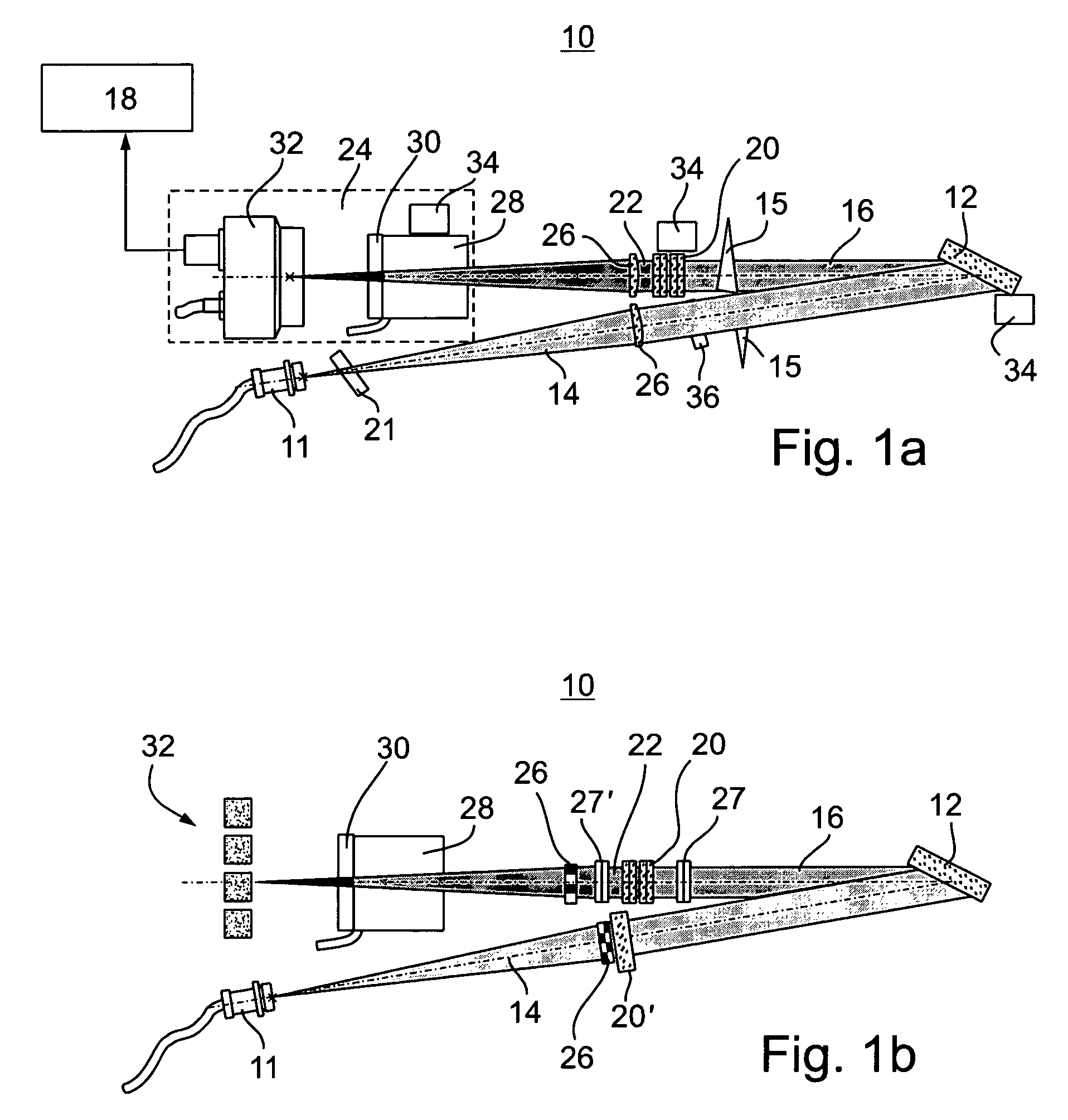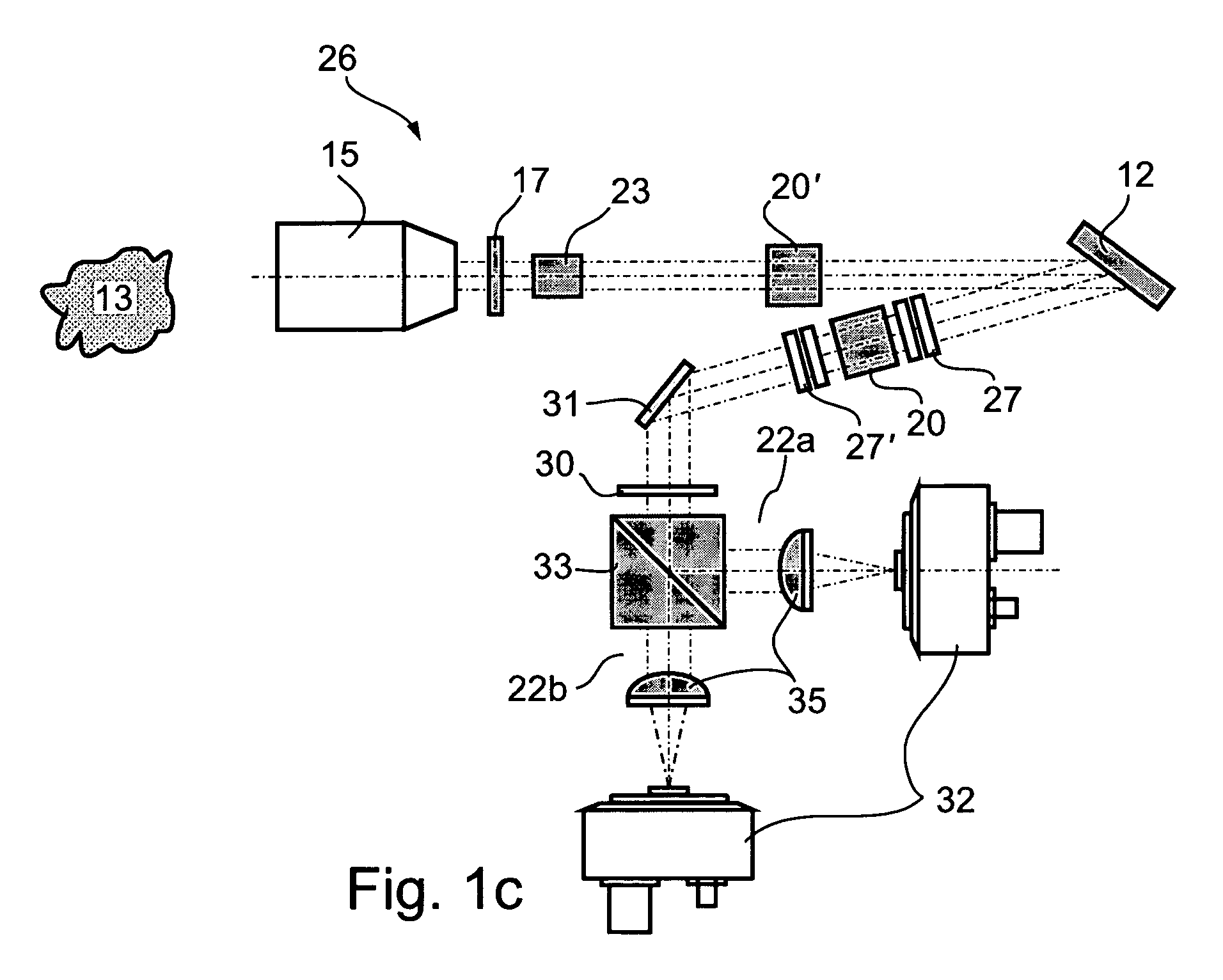Crystal grating apparatus
a crystal grating and apparatus technology, applied in the field of measurement, filtration or separation of light, can solve the problems of two rays interfering with each other, limiting the usefulness of scanned optical signals, modulating light intensity, etc., and achieve the effect of reducing the spot size of ligh
- Summary
- Abstract
- Description
- Claims
- Application Information
AI Technical Summary
Benefits of technology
Problems solved by technology
Method used
Image
Examples
example 1
Determination of Wavelength for a Monochromatic Light
[0273]In its most simple configuration, apparatus 10 can serve as a wavelength meter for a monochromatic light, e.g., a laser light. When only a single wavelength is involved, the integration over the frequencies can be omitted and only one system parameter is preferably used. Thus, once the polarization phase-shift, ΔΦ′, is known (see Equation 8), the wavelength of the light can be extracted either by separated the light, e.g., using a beam splitter, into two detectors and calculating a contrast function, or, by employing the time-dependent polarization phase-shift, as further detailed hereinabove.
[0274]When extracting the wavelength using the contrast function, preferably wide bandwidth detectors are employed, up to GHZ, e.g., silicon or indium or gallium arsenide. In this embodiment, the response time of apparatus 10 is preferably in the GHz scale. Thus, apparatus 10 is capable of measuring transient phenomena unachievable with...
example 2
Determination of Wavelength for Multichromatic Light
[0283]As stated, apparatus 10 can be used as a spectrometer, for the purpose of analyzing a signal having large frequency content. In this case, the output, after the crystal valve, can be written, in the wavelength representation, as:
U=∫ cos2(ΔΦ(λ)+ΔΦvalve)I(λ)dλ, (EQ. 23)
where the cos2 dependence is due to the intensity modulation. Using trigonometric properties one arrives at the following expression:
[0284]2U=∫[cos(2ΔΦ(λ)+2ΔΦvalve)+1]I(λ)ⅆλ=∫[cos(2ΔΦ(λ))cos(2ΔΦvalve)-sin(2ΔΦ(λ))sin(2ΔΦvalve)+1]I(λ)ⅆλ.(EQ.24)
[0285]According to a preferred embodiment of the present invention ΔΦvalve as well as its dependence on time (e.g., periodic), is used so as extract the following individual terms from Equation 24.
Ucos(B)=0.5∫ cos((B(λ−λ0))I(λ)dλ
Usin(B)=0.5∫ sin((B(λ−λ0))I(λ)dλ
Uintg=0.5∫I(λ)dλ. (EQ. 25)
[0286]In biological signals, the spectral dependence is typically modeled as a constant value plus a derivative. ...
example 3
Wavelength Meter and Multi-wavelength Meter
[0289]Apparatus 10 can be used as a wavelength meter to measure, detect or qualify sharp spectral lines, distribution of light with a central wavelength, derivative of a distribution of light, doublet lines (either sharp or distributed), known multipeaks distributions for a small number of peaks and the like.
[0290]The natural dispersion of the grating creates a channel effect. In other words, unlike prior are systems, the angular dispersion of the grating is not used to measure the wavelength value, but rather as a much coarser effect to separate the wavelength into channels in order to measure at once several wavelengths with a small gap therebetween. Whether the wavelengths are sparse or ordered on a grid the multi-wavelength meter provides as much information as a spectrometer with the same wavelength span.
[0291]FIG. 7 shows a spectrum, decoded by a multi wavelength meter, in which each peak is covered by a separate detector or detectors...
PUM
| Property | Measurement | Unit |
|---|---|---|
| time | aaaaa | aaaaa |
| analysis time | aaaaa | aaaaa |
| wavelengths | aaaaa | aaaaa |
Abstract
Description
Claims
Application Information
 Login to View More
Login to View More - R&D
- Intellectual Property
- Life Sciences
- Materials
- Tech Scout
- Unparalleled Data Quality
- Higher Quality Content
- 60% Fewer Hallucinations
Browse by: Latest US Patents, China's latest patents, Technical Efficacy Thesaurus, Application Domain, Technology Topic, Popular Technical Reports.
© 2025 PatSnap. All rights reserved.Legal|Privacy policy|Modern Slavery Act Transparency Statement|Sitemap|About US| Contact US: help@patsnap.com



